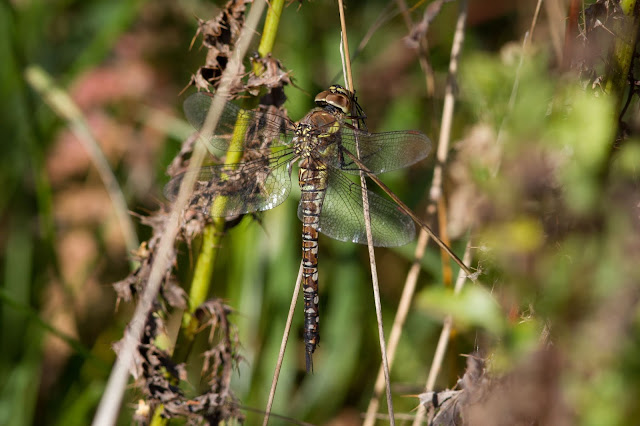I expect the heron is disappointed every time I turn up because it has to move on. It usually watches to see if I climb over the gate before flying off. It is probably after frogs etc as I don't think there are fish in the ponds - one reason why they are so good for dragonflies.
The autumn equinox has seen a change in the weather with windy sunny days and cool nights and there is a distinctly autumnal feel in the air. The dragonfly season seems to have turned as well. For the first time since week 18 I saw no damselflies and there were only three species of dragonfly. The one I was most pleased to find was this female migrant hawker. She was resting low down in the thistles to keep out of the wind.
I saw several males but fewer than last week.
There were still plenty of mating common darters
and several male ruddy darters.
I haven't written much about birds recently as there has been less to say. Little grebes, moorhens and coots are still present but rarely seen. I generally hear or see buzzards, bullfinches, yellowhammers, goldfinches, long-tailed tits and willow warblers each week but this week there were no swallows or martins so I expect they have headed south.
I have seen lots of small coppers this week. Their iridescent orange colours are dazzling in the sunshine.
Other butterflies this week were speckled wood, red admiral, peacock, small white, and this comma.
On a dog rose in one of the hedges I found a Robin's pincushion. It is a gall caused by a solitary wasp, Diplolepsis rosae, which lays its eggs in a rose leaf bud. The grubs develop inside the gall and will emerge next spring. They are produced parthenogenetically and >99% are female.
Several small mushrooms have appeared this week. I think they are conical waxcaps, Hygrocybe conica, also known as witch's hats. Wikipedia says their edibility is uncertain. The flesh apparently turns black when cut, which my friend Maria tells me is not a good sign. I read recently that all mushrooms are edible, but some only once!

















































